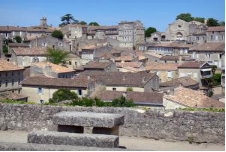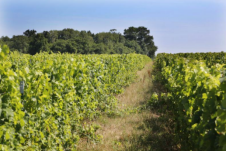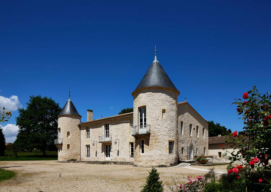Artigues-près-Bordeaux, Gironde, Nouvelle-Aquitaine
I. Population and Area
Total Area: 7, 36 km2 (2.84 sq mi)
Population in 2017: 8 639
Population Density: 1 174 /km2 (3042 /sq mi)
II. Natural Geography (environment and resources)

Location: Artigues-près-Bordeaux (the definitive name dates only from 1926) is a commune in the Entre-deux-Mers located in the urban area of Bordeaux and its urban unit. Integrated into the Bordeaux Urban Community (CUB) since the mid-1960s, it benefited from urban sprawl which accelerated from the 1970s, as well as the establishment of economic activities. Today, with the scarcity of building land, comes the time to build an identity and a territory.
Hydrography: three streams converge to form the Gua in the contact area between Artigues-près-Bordeaux and Lormont. Of the three outlets, the Desclaux is the most important because, already supplied by the runoff of water in the town of Tresses where the built-up areas occupy an increasingly large area, it is reinforced by the Fontaudin. Reservoirs have been made along the Desclaux to avoid flooding in the crossing of Artigues-près-Bordeaux as well as in the municipalities concerned by the Gua before its junction with the Garonne. Due to the proximity of the Garonne, these streams have slightly overcrowded the plateau giving a contrasted pattern.
Communications and transport:
1. TBM network: A new line within the municipality: Citéis line 63. In order to offer a better public transport service to Artiguais, the internal Citeis 63 line went into service on Monday, August 31, 2015. It serves all areas of the city and facilitates travel to municipal facilities as well as to the Saturday morning municipal market. In addition to the 4 existing lines: 27, 40, 64, 80 and 67, this new internal line improves the lives of many Artiguais who can move more easily and access the services of the city including Saturdays.
1) Line 63 which serves municipal facilities from and to Floirac Dravemont, Monday to Saturday.
2) Line 27 which connects the place de Stalingrad to la Buttinière via the commune seven days a week. Frequencies in rush hour every 30 minutes.
3) Line 64 which serves the north of the town, from Monday to Friday, frequency in rush hour every 20 to 30 minutes.
4) Line 67 which serves the north of the town and the inter-municipal cemetery, from and to the Buttinière tram station.
5) Line 40 which links the Buttinière to the Lauriers via the Moulin d'Antoune district from Monday to Saturday.
6) Line 80 which connects avenue des Provinces to place Stalingrad, ensuring a connection with tram A at Floirac Dravemont.
7) The Flexo 68 line provides a service to and from the Buttinière tram station by telephone.
8) To get to Bordeaux by tram, the nearest relay parks are:
-Floirac Dravemont (Reserved for subscribers)
-Buttinière (subscribers and non-subscribers)
III. GDP
l Employment income (%): 75.7 (2016)
l Poverty rate by age group of the tax advisor(%): 10 (2017)
l Average employment income (€):2 444 net per month (29 334 net per year)(2014)
IV. Industrial Characterisitics
In less than half a century, Artigues-près-Bordeaux has gone from the status of an agricultural commune to that of an urban periphery establishing tertiary rather than industrial activities.
From the agricultural vocation, mainly wine, there are only two farms left on the outskirts of the town. Of the very important wine property that constitutes the Sénailhac castle, only a fraction of the land is on Artigues-près-Bordeaux, the rest being located in the neighboring town of Tresses. The vineyards of Château Le Gay, 21 ha almost completely surrounded by urbanization, except on the side of Tresses, are three-quarters in red grapes while white dominated in the 1960s.
Despite the presence of an industrial area since the mid-1960s. Artigues-près-Bordeaux has never had a marked industrial vocation and many closings have occurred among the few settlements carried out. There remains, in particular, a company operating in the biomedical electronics sector, a manufacturer of traffic signs and a specialist in inflatable structures. In connection with nearby traffic flows, services have been installed for vehicles, more particularly for heavy goods vehicles, such as Renault truck in the ZI. Finally, note the presence of APAVE, which occupies two lots on the ZI and intervenes in the field of regulatory controls and technical assistance. Overall, the industrial zone has become tertiary since its creation, in particular thanks to the transformation of old buildings into premises adapted to the expectations of tertiary companies.
Artigues-près-Bordeaux hosted the Gironde branch of the Maison de la Promotion Sociale (MPS). This association, strongly supported by local authorities, provides training missions for people and businesses. In addition, it is able to organize almost all types of event due to its reception and catering capacities. Not far away, the AFT-IFTIM, an association specializing in training in transport and logistics, has set up its Gironde center in the town. Alongside these two important structures, both by their missions and by the areas occupied, there are other companies working in the field of training and professional reintegration, including for the disabled. The presence of four interchanges has attracted businesses in the hotel, catering and above all trade to capture the flows of the entire agglomeration. Some of these businesses line up along the RN 89, such as the But store, but the most numerous are located in areas of activity, often small. Two supermarkets (in Poteau d'Yvrac and Feydeau) cater to local customers. It is not the same for the Castorama and Jardiland stores. On the site of its large DIY area, Castorama inaugurated, in contact with the cemetery park, a Brico-Dépôt, the success of which is such that congestion occurs during peak visits. Jardiland, for its part, closed on the RN 89 interchange in favor of a new location on the RD 936 interchange in order to offer a larger, larger area and thus attract new customers.
V. Attractions
1. Le Jardin d'Emerveille (The Garden of Wonder)

A Shared and Educational Garden "Le Jardin d'Emerveille"
Bringing together sustainable development and solidarity, this is what the City of Artigues-près-Bordeaux aspires to by providing itself on May 11, 2019, the inaugural date, with a shared and educational garden of almost 250m² in the Domaine Bétailhe, "The Garden of Wonder". The inauguration of the place marks the end of several months of co-construction between forty Artiguais, brought together under the leadership of the association SaluTerre, and the partner structures of the town (CCAS, Relais d'Assistantes Maternelles, centers de leisure, Florada activity service…). A real place of welcome, sharing and social diversity, the shared and educational garden is accessible to everyone, especially the elderly, children and the disabled. Together, they can participate in the collective cultivation of fruits and aromatic plants in an atmosphere of mutual aid and sharing.
2. Château de la Prairie (Prairie Castle)
The Château de la Prairie, built in the 19th century, is on the foundations of the former "Le Cornier" residence. This old building, which dates from the 16th century and whose domain extended over almost 29 hectares, was completely destroyed in 1849. The new owners of the domain decided to erect the current Château de la Prairie.
The castle is made up of a main building with a double facade, flanked by two large pavilions terminating in a dome, which gives it a monumental aspect. After spending 50 years in the Carde family, it was sold in 1970 to the Urban Community of Bordeaux, which returned it to the municipality of Artigues. In 1972, the services of the town hall were transferred there. Today, the castle still houses a large part of the municipal services. There is the very beautiful wedding hall, decorated with ornamental decorations. The entire castle is bordered by a large wooded park, a popular promenade for Artiguans.
3. Château Bétailhe (Château Bétailhe)

It is the oldest noble house in the town. Dating from the 12th century, the house is the work of the Chassaigne family, who owned it until the 17th century. Over the centuries and successions, several improvements have been made. But it was not really until 1856, following the acquisition by a man named Mr. Polhs, that major development works took place. Wider crossings are pierced, a peristyle with four columns is added in front of the facade and a tree-like decor is created in the park. The entire rectangular building then consists of a mansion flanked by two pavilions and surrounded by easements, cellars and vats. During this period, the estate extended over almost 70 hectares and produced between 100 and 125 barrels of wine per year. Subsequently, 11 owners succeeded each other until the town hall bought the building in 1984.
This completely restored building, bordered by a park, today hosts various cultural or associative events, the CCAS and the solidarity grocery store.
VI. History
Mainly agricultural until the 1970s, the territory was long divided by the wine estates that made it up. Over the centuries, bourgeois from Bordeaux have acquired by donation, royal fact or acquisition, large estates of several hectares in the center of which castles and noble houses have been built.
Ecclesiastical territory, the town was formed around the parish of Artigues, named in the 13th century and placed under the patronage of Saint Seurin. This parish was formed following large clearings which took place throughout Aquitaine from the 11th century. The town takes its name from the Gascon "artigar" which means "to clear".
In 1926 the town officially took the name of Artigues-près-Bordeaux.
The 1970s opened a new era for the town. It’s the beginning of a metamorphosis. The municipality acquires estates and castles. The town acquired an industrial park and then around fifty housing estates were built on former agricultural land.
It is this history that makes the richness and diversity of the municipal heritage. Here we find large buildings (castles, churches), small elements of buildings (fountains and washhouses), but also a set of parks and woods. All these elements together form the identity of the municipality. Urban and rural town, industrial and natural.
A unique living environment at the gates of Bordeaux.
VII. Other information
A sustainable city : with 184 hectares of woods and parks, the city of Artigues-près-Bordeaux is the green jewel of the right bank. Sensitive to the preservation of this exceptional natural setting, the city is continuing its efforts for the sustainable management of its resources, with in particular the implementation of many systems such as eco-grazing to be discovered on video here, differentiated management at Château Lestrille, the creation of a Educational and Shared Garden) but also an Urban Vegetable Garden accessible to all on the Place du Center-Bourg etc ...
A cultural city: with more than 50 annual meetings, major events and cultural facilities with metropolitan influence, the city is committed to a plural culture.
FLOWERED CITY:
The technical services of the city, responsible for the maintenance of green spaces, saw their work rewarded in 2014 with the obtaining of a second flower awarded by the regional jury of the label "Cities and villages in bloom"
Each year, municipal officials create sets and themed stands. All items are made from reclaimed materials.
Rationalizing energy expenditure, limiting the ecological impact while guaranteeing a quality living environment are objectives of the city in terms of sustainable development. This is why as part of Agenda 21, Artigues has developed actions in terms of differentiated management and more particularly around Château Lestrille.
Each green space is the subject of a specific interview that takes into account its vocation, its aesthetics and its ecological interest.
In order to limit the ecological impact of our actions and to best preserve natural resources, the services have considerably reduced the use of phytosanitary products. The use of weedkillers is today stopped on the sidewalks and strongly limited around the cemetery and the castles. The fertilizers are 100% natural and the green waste is reused for mulching and mulching.
In this context, the green spaces department works the massifs around two principles:
1) The beds of hardy plants, perennials and shrubs, require a low level of maintenance and watering.
2) The annual massifs, whose species are changed twice a year, are mainly installed near the monuments and on roundabouts. The species are selected according to a principle of seasonality but also according to the coherence of the massif.
The town also has a greenhouse of 200m² to ensure better management of plants and a reduction in the cost of annual flowering. Frost plants can be frost-free during the winter before being replanted in the spring.
The good living together and the security of all are strong commitments of the city. In addition to the municipal police service, the town hall has developed new tools for prevention and public tranquility. A local service makes the link between the Artiguais and the municipality. This device makes it possible to respond to everyday problems (deformation of the roadway, wastewater, public lighting, etc.).
Thanks to numerous quality sports facilities, Artigues offers a wide range of disciplines. In club or in leisure, outside or within structures, everyone can practice a sporting activity. The town has a Sports Plain, outdoor equipment, covered equipment.
AGENDA 21
Following the Rio conference in 1992 which set the main guidelines for sustainable development for the 21st century, the French State is committed to promoting and promoting action plans at the local level.
An Agenda 21 must cover various fields of action while pursuing the 5 goals set by the national framework:
- fight against climate change and protection of the atmosphere
- preservation of biodiversity, protection of environments and resources
- fulfillment of all human beings
- social cohesion and solidarity between territories and between generations
- development dynamics following responsible production and consumption modes
In 2005, the city of Artigues-près-Bordeaux responded to the call for projects from the General Council of Gironde and embarked on the realization of an Agenda 21. The first action plan comprising 44 actions was implemented between 2008 and 2014.
The Agenda 21 of Artigues-près-Bordeaux was recognized Local Agenda 21 in 2009 by the Ministry of Ecology, Energy, Sustainable Development and the Sea. The city has been following up on these commitments and taking action in favor of sustainable development with the objectives of building a united, civic and sustainable city.
Since 2015, the municipality has been developing new action plans, including the implementation of differentiated management around the Château Lestrille, eco-grazing in the City Hall Park, the installation of bat nest boxes and tits to fight pests, an educational and shared garden etc....
VIII. Contact information
Artigues-près-Bordeaux town hall address :
Artigues-près-Bordeaux town hall
10 avenue Desclaux
33370 Artigues-près-Bordeaux
Mayor : Anne-Lise Jacquet (Mandat : 2014-2020)
Phone number: 05 56 38 50 50
Fax: 05 56 38 50 68
Mail: mairie@artigues-pres-bordeaux.fr
Website : http://www.artigues-pres-bordeaux.fr
